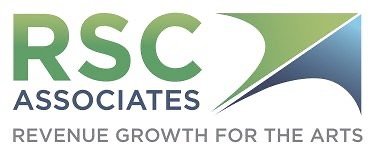MAKING TIME TO FUNDRAISE — YES YOU CAN!
With Bob Swaney
One of the biggest obstacles to sustainable revenue growth? Making time to consistently fundraise.
Whether you're a CEO, a Development Committee member, or a Board member at-large, your job isn’t just about keeping the lights on to provide your art – it’s about building the future. And guess what? That future depends on fundraising. But let’s be honest – most leaders know they should be more engaged in fundraising, yet somehow, there’s rarely enough time.
Listen as we talk about why this happens, and more importantly, how you can fix it.
Read the full transcript below or click the button to listen.
FULL TRANSCRIPT OF THE PODCAST
One of the biggest obstacles to sustainable revenue growth? How leaders consistently make time to fundraise.
Whether you're a CEO, a Development Committee member, or a Board member at-large, your job isn’t just about keeping the lights on to provide your art – it’s about building the future. And guess what? That future depends on fundraising. But let’s be honest – most leaders know they should be more engaged in fundraising, yet somehow, there’s rarely enough time. Today, we will talk about why this happens and, more importantly, how you can fix it. So, let’s dive in.
The Critical Importance of a Healthy Fundraising Program
Let’s start with the facts.
According to the National Center for Arts Research, contributed revenue now accounts for an average of 60% of total income for performing arts organizations. That number continues to grow as operational costs rise and earned revenue – like ticket sales and admissions – fail to keep pace.
And it’s not just the big institutions. Even mid-sized and smaller arts organizations increasingly rely on philanthropy to balance their budgets. According to Giving USA, charitable giving to the arts, culture, and humanities sector totaled over $23.5 billion in 2022, showing that donors continue to value arts organizations – but only if we engage them properly.
The bottom line? If you’re not making time for fundraising, you’re gambling with your organization’s financial health. And let’s be clear – fundraising is not just the Development Director’s job. It’s an organizational priority, and all leadership must lead by example.
Eight Barriers to Consistently Making Time for Fundraising
So why is it so hard to make time for fundraising? Let’s take a closer look at some of the most common barriers, and you should decide which of these sounds most familiar to you.
1. Competing Priorities – If you’re leading an arts organization, your to-do list never ends. There’s always a performance or exhibition to prepare, a budget to finalize, and a crisis to manage. It’s easy to think, “I’ll focus on fundraising later,” but later never comes. The urgent always wins over the important, and fundraising gets pushed to the bottom of the pile.
2. Lack of an Established Routine – Fundraising isn’t something you do once a quarter, as you have time; it’s a daily practice. Many leaders don’t build it into their schedule, treating it as an occasional obligation rather than a discipline. Without a structured routine, it gets lost in the shuffle.
3. Lack of Knowledge or Support in Making an Ask – Let’s be real, asking for money can be intimidating, even for seasoned professionals. If you don’t have the right training or support, it’s easier to avoid it altogether. Many leaders fear rejection, don’t know how to position an ask, or simply don’t have the confidence to initiate those critical donor conversations.
4. Absence of a Culture of Philanthropy – If your Board and staff don’t see fundraising as an organizational value, you’ll always be pushing uphill. If fundraising feels like an isolated department rather than a shared responsibility, you’re missing a key ingredient for success.
5. Not Understanding Why It’s a Daily Priority – Many leaders don’t connect the dots between daily fundraising activities and financial sustainability. They may believe fundraising is only necessary during a campaign or in times of crisis, failing to recognize the long-term impact of consistent donor engagement.
6. Discomfort with Donor Engagement – Some leaders feel awkward discussing money, fearing they’ll come across as transactional or pushy. Others struggle with what to say or worry they’ll say the wrong thing, leading to avoidance.
7. Lack of Clear Expectations and Accountability – Without concrete goals and benchmarks, it’s easy for leadership to disengage from fundraising. If there’s no accountability, there’s no urgency.
8. The Myth of “Somebody Else Will Handle It” – Development staff exist for a reason, but they can’t do it alone. Many CEOs and Board members assume that fundraising isn’t their job, failing to realize that donors expect to hear from leadership.
Overcoming These Barriers
Look, these barriers are real and we’re just scratching the surface. But what do you do to keep fundraising responsibilities front-and-center? Let’s take another look at each of those barriers, with a suggestion on how you can clear the hurdles.
1. Competing Priorities? Block Out Dedicated Time – Treat fundraising as non-negotiable. Block out 30 minutes to an hour each day for donor-related activities. If it’s not on your calendar, it won’t happen.
2. Lack of an Established Routine? Create a Fundraising Habit – Start small. Set a goal to make three donor touches per day – whether it’s a call, an email, or a meeting. The more you do it, the more natural it becomes.
3. Lack of Knowledge or Support? Invest in Training – No one expects you to be a natural-born fundraiser. Attend a workshop, work with a coach, or role-play asks with your team to build confidence.
4. Absence of a Culture of Philanthropy? Embed Fundraising into Organizational Culture – Talk about fundraising in every meeting. Tie donor engagement back to mission impact. Recognize staff and Board members who contribute to fundraising efforts.
5. Not Understanding Why It’s a Daily Priority? Shift the Mindset – Think of fundraising as a relationship-building effort, not a transaction. It’s about ongoing engagement, not just securing a check.
6. Discomfort with Donor Engagement? Reframe the Conversation – Stop thinking of it as “asking for money” and start seeing it as “inviting people to invest in something meaningful.”
7. Lack of Clear Expectations? Set Measurable Goals – Define clear fundraising expectations for leadership. Set benchmarks, track progress, and hold each other accountable.
8. The Myth of “Somebody Else Will Handle It”? Own Your Role – Fundraising is a shared responsibility. Leaders must be actively involved in donor cultivation, stewardship, and solicitation. Only do what ONLY YOU can do in fundraising.
Leadership Styles and Application
You know, one of the things we don’t talk about enough in this field is how leadership style – not just skill or structure – can really shape fundraising outcomes.
Yes, there are mechanical hurdles: not enough staff, unclear goals, bad data – you name it. But there’s also the human side. And I want to touch on that today, because I see it all the time with arts and cultural organizations.
There are three leadership styles I run into over and over again. None are wrong, by the way. But each comes with its own fundraising opportunity – if you lean into it the right way.
Let’s see which one sounds like you.
First, the Visionary CEO.
This is the leader who thinks big. You’ve got bold ideas. You’re out there talking about what’s next – how your organization is going to grow, how you’re going to serve more people, reach new heights, do great art, deepen your impact.
Fantastic. Now do the same with fundraising. Make it a core part of your vision. If your team only hears you talk about the art or the education programs, and never hears you talk about the fuel that makes it all go – philanthropy – you’re sending the wrong message.
Talk about fundraising in every staff meeting. Celebrate gifts, share impact stories, recognize your development staff by name. Show your Board that you take fundraising seriously. When you make it clear that fundraising is mission-critical – not some extra thing you hope someone else takes care of – your whole team will start to show up differently.
Next, the Reluctant Fundraiser.
Look, I get it. You didn’t go into arts leadership to become a salesperson. Fundraising can feel uncomfortable, even a little scary.
But here's the truth: you don’t have to dive in with both feet and start asking for million-dollar gifts on day one. Start small. Make it a point to personally thank a few donors each month. Write a handwritten note. Make a 3-minute phone call. Invite a donor to coffee and just listen to why they care.
The point is, take a few small steps that are relational, not transactional. You’ll be amazed at what those simple actions can do, both for donor loyalty and your own confidence. The ask will come later. But connection comes first. And it’s something you already know how to do.
And finally, the Hands-Off Leader.
You might be more of the manager type. You keep the trains running, you’ve got staff in place, and fundraising? Well, you’ve hired people to do that.
Okay, fair enough. But just because you’re not the one making the ask doesn’t mean you’re off the hook. What your team needs from you is structure. They need systems. And most of all, they need accountability.
That means you help build the annual fundraising calendar. You make sure fundraising goals show up in staff and Board agendas. You track progress on major gift activity – not just dollars in the door, but meaningful engagement.
Your role isn’t to be the face of every campaign, but it is to make sure there’s a clear plan, shared responsibility, and a sense of momentum. That’s what leadership looks like from your chair.
Which one are you? Visionary, reluctant, or hands-off? Like I said, there’s no wrong answer. But there is a missed opportunity if you don’t use your style to lead on fundraising.
Because whether you’re dreaming big, easing in, or just keeping the trains on time – there’s a path forward. And your team, your donors, and your mission are counting on
Wrap-Up
Let’s wrap this up.
If you remember just one thing from today’s pod, let it be this . . .
Fundraising is not an optional part of leadership in the arts – it’s essential. You have the power to make fundraising a daily priority. Your organization’s future depends on it.
That’s it for today’s episode of Fundraising Growth Now! If you found this discussion helpful, share it with your Board, your colleagues, and your development committee. And as always, keep growing, keep leading, and keep fundraising!



